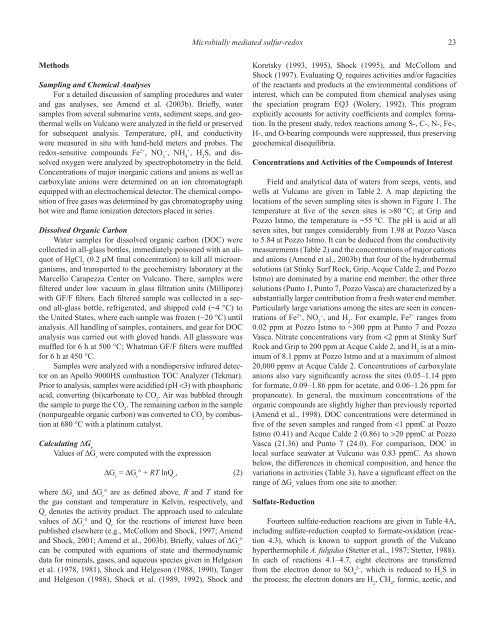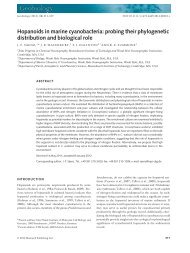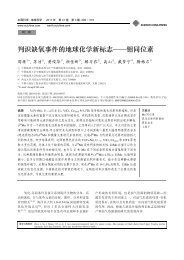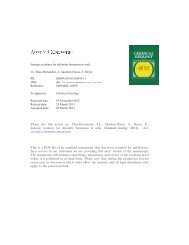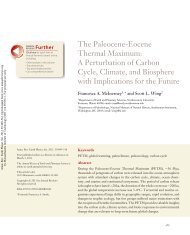Sulfur BiogeochemistryâPast and Present
Sulfur BiogeochemistryâPast and Present
Sulfur BiogeochemistryâPast and Present
- No tags were found...
Create successful ePaper yourself
Turn your PDF publications into a flip-book with our unique Google optimized e-Paper software.
Microbially mediated sulfur-redox 23MethodsSampling <strong>and</strong> Chemical AnalysesFor a detailed discussion of sampling procedures <strong>and</strong> water<strong>and</strong> gas analyses, see Amend et al. (2003b). Briefly, watersamples from several submarine vents, sediment seeps, <strong>and</strong> geothermalwells on Vulcano were analyzed in the field or preservedfor subsequent analysis. Temperature, pH, <strong>and</strong> conductivitywere measured in situ with h<strong>and</strong>-held meters <strong>and</strong> probes. Theredox-sensitive compounds Fe 2+ , NO 3−, NH 4+, H 2S, <strong>and</strong> dissolvedoxygen were analyzed by spectrophotometry in the field.Concentrations of major inorganic cations <strong>and</strong> anions as well ascarboxylate anions were determined on an ion chromatographequipped with an electrochemical detector. The chemical compositionof free gases was determined by gas chromatography usinghot wire <strong>and</strong> flame ionization detectors placed in series.Dissolved Organic CarbonWater samples for dissolved organic carbon (DOC) werecollected in all-glass bottles, immediately poisoned with an aliquotof HgCl 2(0.2 µM final concentration) to kill all microorganisms,<strong>and</strong> transported to the geochemistry laboratory at theMarcello Carapezza Center on Vulcano. There, samples werefiltered under low vacuum in glass filtration units (Millipore)with GF/F filters. Each filtered sample was collected in a secondall-glass bottle, refrigerated, <strong>and</strong> shipped cold (~4 °C) tothe United States, where each sample was frozen (−20 °C) untilanalysis. All h<strong>and</strong>ling of samples, containers, <strong>and</strong> gear for DOCanalysis was carried out with gloved h<strong>and</strong>s. All glassware wasmuffled for 6 h at 500 °C; Whatman GF/F filters were muffledfor 6 h at 450 °C.Samples were analyzed with a nondispersive infrared detectoron an Apollo 9000HS combustion TOC Analyzer (Tekmar).Prior to analysis, samples were acidified (pH 80 °C; at Grip <strong>and</strong>Pozzo Istmo, the temperature is ~55 °C. The pH is acid at allseven sites, but ranges considerably from 1.98 at Pozzo Vascato 5.84 at Pozzo Istmo. It can be deduced from the conductivitymeasurements (Table 2) <strong>and</strong> the concentrations of major cations<strong>and</strong> anions (Amend et al., 2003b) that four of the hydrothermalsolutions (at Stinky Surf Rock, Grip, Acque Calde 2, <strong>and</strong> PozzoIstmo) are dominated by a marine end member; the other threesolutions (Punto 1, Punto 7, Pozzo Vasca) are characterized by asubstantially larger contribution from a fresh water end member.Particularly large variations among the sites are seen in concentrationsof Fe 2+ , NO 3−, <strong>and</strong> H 2. For example, Fe 2+ ranges from0.02 ppm at Pozzo Istmo to ~300 ppm at Punto 7 <strong>and</strong> PozzoVasca. Nitrate concentrations vary from


